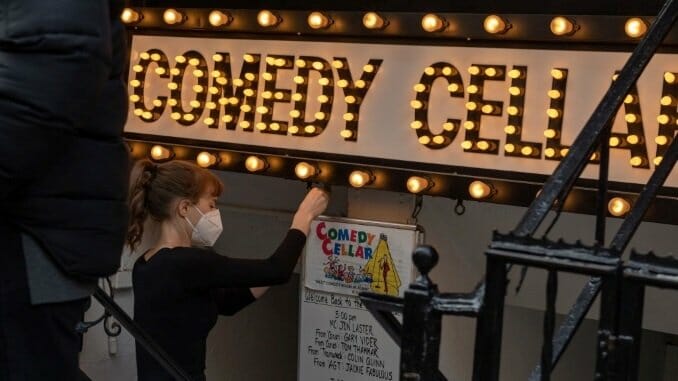Yes, You Should Still Wear a Mask at the Comedy Club
Photo courtesy of Getty Images
In April the piecemeal reopening of comedy clubs across the country finally reached two longstanding holdouts: New York, which allowed indoor entertainment venues to reopen at limited capacity on April 2nd, and California, where indoor performances were cleared to resume earlier this month, with restrictions varying by county. In Los Angeles, which appears set to enter the least restrictive tier of reopening early next month, the Comedy Store is planning a grand reopening in its Main Room tonight. The Laugh Factory, half a mile down the street, will hold a “soft reopening” tomorrow.
The reopening of comedy’s capital cities draws renewed attention to safety issues that have dogged the industry for the past year, as headliners toured the country performing in states with differing health guidelines and negligible enforcement. Some states didn’t require masking or distancing at all; others declined to penalize clubs that ignored the rule. A number of high-profile comedians, like Dave Chappelle and Brian Regan, tested positive for Covid-19 while on the road, raising questions about audience and employee safety. Still the industry chugged indefatigably toward something resembling normalcy—albeit at reduced capacity, with a negative test result or vaccination card required at the door.
Those safety issues have never been resolved. Central to the reopening of indoor comedy is a contradiction that also defined the reopening of indoor dining, itself connected to a raftofCovid-19outbreaks: the science says you should avoid unnecessary indoor gatherings with people outside your household, and if you can’t then you should wear a mask. The guidance clears you to remove your mask periodically throughout indoor gatherings with people outside your household, if not the entire time. In New York, comedy audiences “may temporarily remove their face covering when seated at an assigned seat/area to eat or drink.” In California, masks are “mandatory unless actively eating and/or drinking”; likewise in Ohio. In Texas, you are “strongly encouraged” to wear a mask when you can’t stay six feet away from your fellow patrons—that is, when you’re at your seat—but the state forbids local governments from enforcing mandates. In Utah, you must similarly mask up “when physical distancing is not feasible.” In Florida, you can pretty much do whatever you want, as close as you want to whoever you want: some localities still have mask orders, but as in Texas they’re barred from fining violators. The list goes on.
In practice, these rules amount to a pass on wearing a mask at comedy clubs, whether or not you’re putting food in your mouth. A brief scan of social media images taken at clubs in alltheabovestatesandmore suggests that if it is not the norm for comedy clubs to adopt a “mask up if you want” policy, then they are at the very least lax about enforcing state guidelines. From these images emerge some obvious questions: Does it matter? How safe are comedy audiences under the rules as written, and how safe are they under the rules as observed?